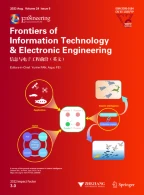Abstract
Enterprise architecture (EA) efforts focus on business, technology, data, and application architecture, and their integration. However, less attention has been given to one of the most critical EA elements, i.e., users (EA audiences). As a result, existing EA management systems (EAMS) have become old, large, content-centric document-repositories that are unable to provide meaningful information of use to the enterprise users and aligned with their needs and functional scope. We argue that a semantic technology based mechanism focusing on enterprise information and user-centricity has the potential to solve this problem. In this context, we present a novel ontology-based strategy named the user-centric semantics-oriented EA (U-SEA) model. Based on this model, we have developed a user-centric semantics-oriented enterprise architecture management (U-SEAM) system. Our approach is generic enough to be used in a wide variety of user-centric EAM applications. The results obtained show computational feasibility to integrate and govern enterprise information and to reduce complexity with respect to interoperability between enterprise information and users.
Similar content being viewed by others
References
Aier, S., Marten, S., 2006. Evaluating Integration Architectures: A Scenario-Based Evaluation of Integration Technologies. Springer Berlin Heidelberg, p.2–14.
AIIM, 2008. What Are the Components of an Information Governance Framework? Available from http://www.informationzen.org/group/governancecompliance/forum/topics/2043787:Topic:306 [Accessed on Sept. 28, 2008].
Babu, M., Aziz, S., Obitz, T., 2008. Findings from the Enterprise Architecture Survey. Executive Summary. Infosys. Available from http://www.infosys.com/offerings/IT-services/architecture-services/ea-survey/Documents/EA-survey-2008.pdf [Accessed on Apr. 25, 2009].
Blumenthal, N.A., 2007. User-Centric EA. US Coast-Guard, DoD Presentation Session. Available from http://www.information-management.com/infodirect/2008_70/10001224-1.html [Accessed on Mar. 1, 2009].
Cornelis, C., Lu, J., Guo, X.T., Zhang, G.Q., 2007. One-and-only item recommendation with fuzzy logic techniques. Inform. Sci., 177(22):4906–4921. [doi:10.1016/j.ins.2007.07.001]
Cui, Z., Tamma, M., Bellifemine, F., 1999. Ontology management in enterprises. BT Technol. J., 17(4):98–107. [doi:10.1023/A:1009655311119]
DCMI, 1995. The Dublin Core Metadata Initiative. Available from http://dublincore.org/ [Accessed on Feb. 15, 2009].
DOAP, 2007. Description of a Project. Available from http://trac.usefulinc.com/doap [Accessed on Dec. 12, 2008].
DoDAF, 2007a. Architecture Data Description, Volume III. Available from www.defenselink.mil/cio-nii/docs/DoDAF_Volume_III.pdf [Accessed on Aug. 4, 2008].
DoDAF, 2007b. Definitions and Guidelines. Version 1.5. Available from http://www.defenselink.mil/cio-nii/docs/DoDAF_Volume_I.pdf [Accessed on Nov. 18, 2008].
ECU (Economist Intelligence Unit), 2008. The Future of Enterprise Information Governance. White Paper, The Economist. Available from http://www.emc.com/leader-ship/business-view/future-information-governance.htm [Accessed on Jan. 15, 2008].
FEA, 2007. FEA Consolidated Reference Model Document. Version 2.3. Federal Enterprise Architecture Program Management Office, OMB. Available from http://www.whitehouse.gov/omb/assets/fea_docs/FEA_CRM_v23_Final_Oct_2007_Revised.pdf [Accessed on Oct. 23, 2008].
ISO, 1999. Human-Centered Design Processes for Interactive Systems. Available from http://www.iso.org/iso/catalo-gue_detail.htm?csnumber=21197 [Accessed on Oct. 24, 2008].
Ittoo, A.R., Zhang, Y., Jiao, J., 2006. A Text Mining-Based Recommendation System for Customer Decision Making in Online Product Customization. Proc. IEEE Int. Conf. on Management of Innovation and Technology, p.473–477. [doi:10.1109/ICMIT.2006.262208]
LEKS, 2008. Enterprise Ontology: A Position Statement. Available from http://crinfo.univ-paris1.fr/Missikoff-EnterpriseOntology-Introd.pdf [Accessed on Mar. 7, 2009].
Mena, E., Kashyap, V., Shet, A., Illarramendi, A., 1996. OBSERVER: An Approach for Query Processing in Global Information Systems Based on Interoperation across Pre-existing Ontologies. Proc. 1st IFCIS Int. Conf. on Cooperative Information Systems, p.14–25. [doi:10.1109/COOPIS.1996.554955]
OWL, 2008. Ontology Web Language. Available from http://www.w3.org/TR/owl-guide/ [Accessed on Nov. 17, 2008].
Qiu, R.G., 2006. Towards ontology-driven knowledge synthesis for heterogeneous information systems. J. Intell. Manuf., 17(1):99–109. [doi:10.1007/s10845-005-5515-z]
Ross, J.W., Peter, W., David, C.R., 2006. Enterprise Architecture as Strategy Creating a Foundation for Business Execution. Harvard Business School Press, Boston, Massachusetts, USA.
Schekkerman, J., 2004. How to Survive in the Jungle of Enterprise Architecture Frameworks? Trafford Publishing, Victoria, Canada.
Veltman, K.H., 2001. Syntactic and semantic interoperability: new approaches to knowledge and the semantic Web. New Rev. Inform. Netw., 7(1):159–183. [doi:10.1080/13614570109516975]
Zachman, J.A., 1987. A framework for information systems architecture. IBM Syst. J., 26(3):276–292.
Zachman, J.A., 2005. Enterprise Architecture Artifacts vs Application Development Artifacts. Zachman Institute for Framework Advancement. Available from http://www.zifa.com/cgi-bin/download.cgi?file_name=ZIFA05. pdf&file_path=/home/stagingArea/zifa.com/friends/ZIFA05.pdf&size=164365 [Accessed on Aug. 25, 2009].
Author information
Authors and Affiliations
Corresponding author
Rights and permissions
About this article
Cite this article
Ghani, I., Lee, C.Y., Juhn, S.H. et al. Semantics-oriented approach for information interoperability and governance: towards user-centric enterprise architecture management. J. Zhejiang Univ. - Sci. C 11, 227–240 (2010). https://doi.org/10.1631/jzus.C0910508
Received:
Accepted:
Published:
Issue Date:
DOI: https://doi.org/10.1631/jzus.C0910508
Key words
- Enterprise architecture management system (EAMS)
- Ontology
- Recommender system
- User-centric
- Semantic Web
- Framework
